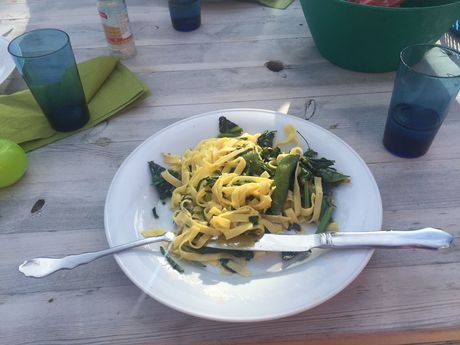Swedish researchers prepare a meal for the future

It may look like a simple meal of pasta with vegetables, but Swedish researchers believe they have prepared a true meal for the future, when plants modified with the ‘genetic scissors’ CRISPR-Cas9 were cultivated, harvested and cooked.
Stefan Jansson, professor in Plant Cell and Molecular Biology at Umeå University, served ‘Tagliatelle with CRISPRy fried vegetables’ to a radio reporter.
CRISPR (clustered regularly interspaced short palindromic repeats)-Cas9 is a complicated name for a simple, but targeted, way of changing the genes of an organism. The discovery was published in 2012 by researchers at Umeå University, and the ‘Swiss Army knife of genetic engineering’ has been predicted to change the world.
With CRISPR-Cas9, researchers can either replace one of the billions of ‘letters’ present in an organism’s genome (ie, the entire gene pool consisting of DNA) or remove short segments. The technology is called ‘gene editing’ or ‘genome editing’.
The first clinical applications are underway and it is hoped one day it will assist in curing hereditary disease. However, in the agricultural field the issue is not if researchers can create more sustainable plants with the technology, but rather whether these will be allowed in farming.
If plants whose genome has been edited using CRISPR-Cas9 fall under GMO legislation, it makes them illegal to plant in many parts of the world. If not, they will be allowed to be grown at the farmer’s own discretion.
In November 2015, the Swedish Board of Agriculture interpreted the law to mean that if only a segment of DNA has been removed and no ‘foreign DNA’ has been inserted, it is not to be regarded as a genetically modified organism — a GMO. That means the plant can be cultivated without prior permission. In spring 2016, American authorities agreed. The organism in question there was a mushroom which had lost the part of its DNA that made it go brown.
This opens up the possibility of using the technology to develop plants of the future. This European summer has been the first time that plants — specifically cabbage — that have been gene-edited using CRISPR-Cas9 have been allowed to be cultivated outside of the lab.
“The CRISPR plants in question grew in a pallet collar in a garden outside of Umeå in the north of Sweden and were neither particularly different nor nicer looking than anything else,” said plant scientist Stefan Jansson. But they represent a new phase of agriculture: where scientific advances will be implemented in new plant species to create a meal for the future.
Chocolate consumption trends in the US
Chocolate sales hit a new high in the US as it remains an 'affordable treat' duing...
Ready-made infant, toddler food study finds some falling short on nutrition
Some ready-made foods for infants and toddlers being sold in Australia are not meeting WHO...
PepsiCo achieves 3.5 Health Star Rating with chip ranges
PepsiCo Australia has achieved a 3.5 Health Star Rating (HSR) for its low-salt and baked potato...














